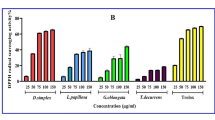Abstract
While there is increasing evidence that marine bacteria are involved in the production of paralytic shellfish toxins in algal blooms, the exact roles of the bacteria and microalgae have proved elusive. A novel experimental approach to this problem involved incubating parallel cultures of toxin producing Alexandrium minutum Anokoha A in the dark and in a natural daylight cycle. High-performance liquid chromatography was used to measure paralytic shellfish toxins while bacterial growth was monitored by culture on high- and low-nutrient agar media. After a 22-day incubation period in the dark, A. minutum Anokoha A failed to produce saxitoxin while parallel light-grown cultures produced 1.17 μg per 10,000 algal cells. However, both dark- and light-grown cultures showed comparable gonyautoxin production. Copiotrophic and oligotrophic algal-associated bacteria showed similar growth patterns over the incubation period except that a dip in bacterial numbers corresponded to a peak in algal numbers in the light-grown cultures. It appears that inhibition of photosynthesis resulted in changes in the toxin profile of A. minutum Anokoha A. When used with other methods, this approach may help to elucidate the algal–bacterial-toxin connection.


Similar content being viewed by others
References
Anderson DM, Kulis DM, Sullivan JJ, Hall S, Lee C (1990) Dynamics and physiology of saxitoxin production by the dinoflagellates Alexandrium spp. Mar Biol 104:511–524
Chang F (1995) The first records of Gymnodinium sp. nov. (cf. breve) (Dinophyceae) and other harmful phytoplankton species in the early 1993 blooms in New Zealand. In: Lasus P, Arzul G, Gentien P, Marcaillou C (eds) Harmful Marine Algal Blooms Technique et Documentation. Lavoisier, Intercept, Paris, pp 27–32
Chang FH, MacKenzie L, Till D, Hannah D, Rhodes L (1995) The first toxic shellfish outbreaks and the associated phytoplankton blooms in early 1993 in New Zealand. In: Lasus P, Arzul G, Gentien P, Marcaillou C (eds) Harmful Marine Algal Blooms Technique et Documentation. Lavoisier, Intercept, Paris, pp 145–150
Doucette GJ (1995) Interactions between bacteria and harmful algae: a review. Nat Toxins 3:65–74
Gallacher S, Smith EA (1999) Bacteria and paralytic shellfish toxins. Protist 150:245–255
Gerhardt P, Murray RGE, Costilow RN, Nester EW, Wood WA, Krieg NR, Briggs Phillips G (eds) (1981) Manual of methods for general bacteriology. American Society for Microbiology, Washington DC, p 524
Ho AYT, Hsieh DPH, Qian P-Y (2006) Variations in paralytic shellfish toxin and homolog production in two strains of Alexandrium tamarense after antibiotic treatments. Aquat Microb Ecol 42:41–53
Hold GL, Smith EA, Birkbeck TH, Gallacher S (2001) Comparison of paralytic shellfish toxin (PST) production by the dinoflagellates Alexandrium lusitanicum NEPCC 253 and Alexandrium tamarense NEPC 407 in the presence and absence of bacteria. FEMS Microbiol Ecol 36:223–234
Lim P-T, Leaw C-P, Usup G (2006) Effects of light and temperature on growth, nitrate uptake and toxin production of two tropical dinoflagellates: Alexandrium tamiyavanichii and Alexandrium minutum (Dinophyceae). J Phycol 42:786–799
Lu Y-H, T-j C, Hwang D-F (2000) Isolation of bacteria from dinoflagellate Alexandrium minutum and their effects on algae toxicity. J Nat Toxins 9:409–417
Maas EW, Thiele J, Thompson C, Latter RM, Brooks HJL (2000) Modification of an algal culture medium for sustained growth of a saxitoxin-producing isolate of Alexandrium minutum. J Appl Phycol 12:95–98
Maas EW, Latter RM, Thiele J, Waite A, Brooks HJL (2007) Effect of multiple antibiotic treatments on a paralytic shellfish toxin-producing culture of the dinoflagellate Alexandrium minutum from Anakoha Bay New Zealand. Aquat Microb Ecol 48:255–260
MacKenzie L (1994) A bloom of Alexandrium minutum in Anakoha Bay, Marlborough Sounds (Dec 1993–Jan 1994). Seafood NZ 2:50–52
MacKenzie L, Berkett N (1997) Cell morphology and PSP-toxin profiles of Alexandrium minutum in the Marlborough Sounds, New Zealand. NZ J Mar Freshwater Res 31:403–409
Michaud S, Levasseur M, Doucette G, Cantin G (2002) Particle size fractionation of paralytic shellfish toxins (PSTs): seasonal distribution and bacterial production in the St Lawrence estuary, Canada. Toxicon 40:1451–1462
Shimizu Y (1987) Dinoflagellate toxins. In: Taylor FJR (ed) The biology of dinoflagellates. Blackwell, Oxford, pp 282–315
Smith EA, Mackintosh FH, Grant F, Gallacher S (2002) Sodium channel blocking (SCB) activity and transformation of paralytic shellfish toxins (PST) by dinoflagellate-associated bacteria. Aquat Microb Ecol 29:1–9
Uribe P, Espejo RT (2003) Effect of associated bacteria on the growth and toxicity of Alexandrium catenella. Appl Environ Microbiol 69:659–662
van Apeldoorn ME, van Egmond HP, Speijers GJ, Bakker GJ (2007) Toxins of cyanobacteria. Mol Nutr Food Res 51:7–60
Whittle K, Gallacher S (2000) Marine toxins. Br Med Bull 56:236–253
Acknowledgments
We thank Lincoln MacKenzie, Cawthron Institute, Nelson, New Zealand for the continued use of his A. minutum Anakoha A isolate. E.W.M was funded by a HRC postgraduate scholarship. We thank the Cawthron Institute, Nelson, New Zealand for the use of their HPLC and toxin standards and A. Wade for assistance with graphs.
Author information
Authors and Affiliations
Corresponding author
Rights and permissions
About this article
Cite this article
Maas, E.W., Brooks, H.J.L. Is photosynthesis a requirement for paralytic shellfish toxin production in the dinoflagellate Alexandrium minutum algal–bacterial consortium?. J Appl Phycol 22, 293–296 (2010). https://doi.org/10.1007/s10811-009-9458-1
Received:
Revised:
Accepted:
Published:
Issue Date:
DOI: https://doi.org/10.1007/s10811-009-9458-1




